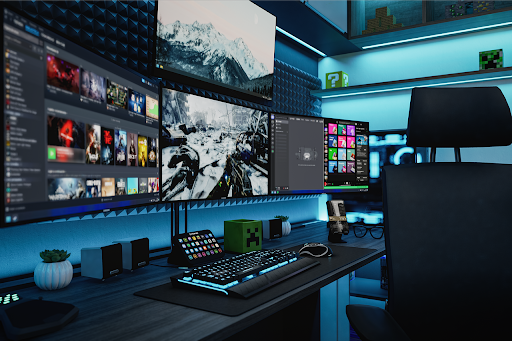Gaming has become a major force in the entertainment industry, surpassing movies and music by quite a few miles. According to statistics from 2020, the movie industry was valued at USD 41.7 billion, and music was valued at USD 19.1 billion globally. In the same period, gaming boosted a market size of no less than USD 159.3 billion, over three times music and movies combined. There’s still a lot of room for growth, as projections point to a market size of over USD 388 billion by 2033.
New games have incorporated features of both industries, with Hollywood actors as main characters, highly elaborated soundtracks, and compelling stories. Also, the technology behind digital games is more advanced than ever, creating incredibly realistic scenarios and gameplay. Is it possible to go even further? Yes, and here’s how.
AI and Machine Learning
It’s difficult to overstate the impact of artificial intelligence and machine learning in the gaming industry. AI algorithms breathe life into non-playable characters (NPCs) who now act much more lifelike, way beyond the repetitive and pre-programmed interactions of the past. Meanwhile, machine learning creates new missions and scenarios according to players’ skill levels and gaming habits.
As a result, the gaming experience has become much more personalized and surprising. When combined, AI and machine learning open space for procedural content generation (PCG), creating new scenarios automatically. It’s a huge leap in gaming development, as developers no longer need to create adventures frame by frame.
Quality Management
Amid so many flashy technologies and features, one of the biggest transformations is happening behind the scenes. Quality management is key to developing any product, and games aren’t different. In gaming, advanced tools like QMS Software automate testing, reports, localization, and quality assurance during the development process to ensure only the best games will hit the shelves.
Microtransactions
In-game purchases and microtransactions are already here, but these features will likely be incorporated into more games. Such features allow players to personalize their characters with exclusive skins and items, but not only so. In fact, they create new ways of monetization since such items can also be traded in specialized marketplaces for real money.
These transactions also pave the way for play-to-earn models, where in-game assets become rewards for completed missions. It’s exciting for players and a business opportunity for developers. Instead of generating revenue only by selling games, in-game transactions create a continuous source of revenue.
New Realities
There’s still a lot of room for growth for VR and AR, but these devices are becoming more affordable as big techs like Meta and Google compete for this market. The number of games for such platforms is already rising and will likely rise even further as more players buy these gadgets.
Indeed, these technologies are the latest words in immersive gaming, a desirable feature in any adventure. Virtual reality headsets create 360º scenarios in which players can, almost literally, walk around. Augmented reality isn’t less exciting, overlaying gaming content onto real-life scenarios, very much like Pokemon Go.
The Rise of Indie Games
Indie games are famously less complex than AAA titles, but it doesn’t mean they are less popular. In fact, platforms like Roblox are bridging the gap between indie developers and the public, allowing for much more effective distribution of new games. More importantly, developers can create their games on the platform with the Roblox Studio game engine. Searches for Roblox have risen 57% in the past five years, a trend that will likely remain.
Better Consoles
The console marketing is mostly dominated by PlayStation, Xbox, and Nintendo. New models, such as PlayStation 5 and Xbox Series X, keep emerging, and the widely popular Nintendo Switch is not too far behind. The PlayStation 5 brings significant upgrades compared to its previous version, including a high-end SSD, resulting in much less loading times.
Meanwhile, Xbox has invested in a Smart Delivery system, where gamers can get free Series X versions of games that run on Xbox One. The console war is still ongoing, and at this moment, PS5 seems to be ahead in the race, selling five times more consoles than its biggest competitor. Still, competitiveness is the name of the game, and Xbox can flip the scores at any moment. Such competition is great news for gamers, who will likely be treated to more engaging games and efficient consoles.
Cloud Gaming
Players no longer need a top-notch console to play the most advanced games, which now run on most devices through Netflix-like platforms. Cloud gaming has grown impressively in the past five years by 975% more precisely. As any PlayStation user will know, downloading new games can take endless hours.
Cloud gaming platforms make games much more accessible as they run even on mobile devices. It explains why their user base has grown so much, now counting on over 290 million excited gamers worldwide. Unsurprisingly, PlayStation has also jumped into the cloud wagon with PlayStation Plus.






